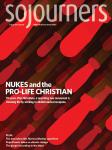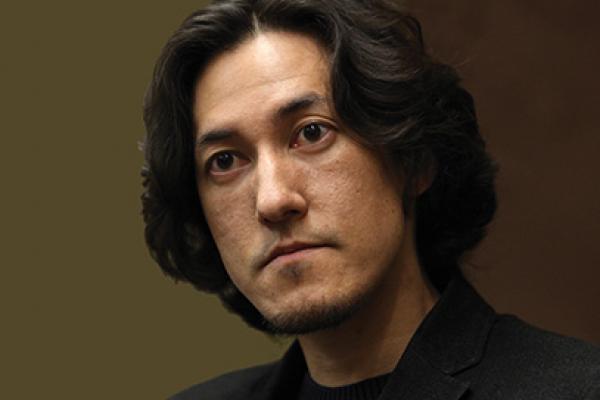“THE IDEA THAT peace is inevitable is as dangerous as the idea that war is inevitable,” says author and peace educator Paul K. Chappell. We’ve been discussing peace in practice for the better part of an hour, and he’s warming to the theme. He puts forward an unlikely premise—that violence is not intrinsic to human nature.
Paul Chappell isn’t what you would expect in a peace champion. A graduate of West Point and a member of the U.S. military for seven years, including as a captain in Iraq, he first honed his fighting skills on school playgrounds, getting expelled for fighting in grade school and suspended in high school. He was bullied as a child for his skin color (his father, a veteran of the Korean and Vietnam Wars, was biracial—black and white—and his mother is Korean). Because of his father’s war trauma, Chappell describes his childhood as “unpredictably violent.”
It’s hard now to imagine this former troubled youth, both perpetrator and victim of violence, as the articulate Chappell thoughtfully winds his way through classical theory and national myth. But Chappell’s learned taste for creed over instinct is clear. The army provided the closest thing to family that a young Chappell had ever encountered, he tells me, but despite that deep affection—or perhaps because of it—he began paying attention to the lasting effects of war and trauma on his brothers-and-sisters-in-arms.
What he discovered about the effects of trauma on the human psyche provided the spark for his peace trainings—conducted with First Nations peoples in Nova Scotia; war-torn communities in Gulu, Uganda; model U.N. participants in Germany; high school students in Washington, D.C.; and college students and justice groups across the U.S.—as well as his book series, The Road to Peace (the latest installment is due in late 2015). The series is a heavily psychological, almost clinical examination of violence and peacemaking—Chappell says he “studies war like a doctor studies illness”—with a decidedly provocative edge.
“The belief that humans are fundamentally violent is a constructed myth,” says Chappell, who also serves as peace leadership director for the Nuclear Age Peace Foundation.
“We have myths about gender and race. And we have myths about violence—about who we are, and about what we must do as a result.”
For centuries, Christians committed to nonviolence have sought to speak out against the state’s use of violence to divide, kill, maim, and threaten other humans made in the image of God. But the institutions of power that protect the state—any state—prove resistant to this call.
Chappell is positioning himself at the corner of moral wisdom, battle tactics, and civil rights movements in an attempt to create new narratives for peacemakers and refute old, damaging ones.
One of those old narratives is that if violence is fundamental, it is inevitable—an assertion Chappell doggedly works to reject.
“Violence has preventable causes just like physical illness has preventable causes,” he says. “If anyone today gets [sick], people realize something has gone wrong. When someone gets malaria, cancer, Ebola, or AIDS, I have never heard anyone say ‘that is human nature.’ But when people are violent, we say, ‘Well, it’s just human nature; we have to bomb people.’”
Chappell also rejects an opposite, idealistic conclusion: Humans are inherently peaceful. He says, continuing with the disease analogy, “You can’t say human beings are inherently healthy, because there are sick people all over the world. Nevertheless, we are supposed to be healthy, because it furthers our survival. In a similar way, we are supposed to be peaceful, even though many people are not.” His conclusion: War and peace are always choices, and both require our participation. “We can choose to resolve the hidden causes of violence or surrender to them.”
This is a distinctly discomfiting statement for many of us in the U.S., who may publicly condemn movements toward war while inwardly believing that nothing will change our military industrial complex. It’s perhaps more disconcerting for churches, who may discuss violence in the world but less often point out the violence done in our name, and who rarely devote resources to learning the ins and outs of national security, or what practical influence citizens have on our foreign policy, or how churches may serve as useful levers in the work for peace.
From a Christian perspective, Chappell’s argument preferences the church’s historical role in nonviolent movements over its doctrine of original sin. The latter implies humanity will always choose violence due to our fallen nature and bolsters a false belief that war-making is inevitable and the best option available. Chappell encourages rigorous questioning of received frameworks: We are surrounded by the myth that violence simply will happen, as a natural course of human life. And for many of us, that myth is enough to drive us into passive, Ecclesiastes-style lament.
Before he became an outspoken proponent for peace, Chappell became intimately acquainted with one source of this myth during his time in the army.
“Seeing how the military trains people to function in very extreme environments reveals a lot about human behavior,” says Chappell. “In order to wage war, we have to create some kind of [psychological] distance. Narratives of ‘they’re evil, they’re subhuman, barbarians, not like us.’ All countries around the world and in history have used very similar messages about adversaries.”
Nationalism and mythmaking
This otherizing narrative that engenders camaraderie among U.S. fighters and transforms rival forces into evil enemies is played out on the public stage as well, where it is usually wrapped in political zeal, patriotic identity, and even religious fervor.
“I see more religious reverence on Veteran’s Day than I see on Christmas. ... If you oppose the war system, you’re regarded as something of a heretic,” says Chappell.
At least in public rhetoric, the United States treats its warriors as heroes. Most of us are familiar with the pageantry surrounding even lowly and bungled aggressions—George W. Bush landed on an aircraft carrier to declare victory in Iraq; Nobel Peace Prize-winning Barack Obama stopped the presses to reveal the capture and killing of Osama bin Laden.
How do other societies “do war”? Is the myth of inevitable violence a purely American one, designed to shore up imperial influence? Here Chappell’s research is surprising.
“War propaganda functions the same way in every culture and time, period,” he says. “Every government in history has said they’re fighting for peace and safety ... for self-defense or freedom. If you give people purpose and meaning, people will go without food, without water, will willingly die for something.
“When we understand that belonging is a basic human drive that can actually overpower physical drives, we better understand nationalism.”
Chappell’s attempt to map the psychology of violence has implications for understanding and diffusing conflict at all levels. Recent political demonstrations, from Tahrir Square to West Baltimore, have arisen from citizens aggrieved by abuses by states or economies that cut significant portions of a population out of a larger identity narrative.
As a result, the tactics across time and cultures for recruiting people to violence often follow a similar psychology—displaced, lonely, disoriented individuals are targeted with the promise of an in-group that provides both material needs and a sense of kinship, power, and larger purpose.
In that lens, the operating myths of terror groups, militaries, and criminal gangs start to look not so very different. It’s a disturbing thought, but it shouldn’t be a new one—the same patterns also map into our neighborhoods and homes.
“A big part of the problem is that our society does not provide an alternative source of purpose and meaning that people find fulfilling,” says Chappell. “How do we give people a stable sense of worth and meaning? Humans hunger for that, and our society right now doesn’t do a good job of filling that hunger.”
Church as peace-wagers
In the U.S. the church used to help fill that hunger. But the Religious Landscape Study from Pew Research Center released in May shows just how far the church is in decline. In just seven years, the share of Americans who don’t identify with any religion has risen sharply, to 23 percent.
In terms of national narrative creation, the church’s gospel of nonviolent peace stands several steps below the state’s gospel of war-for-peace.
But 44 percent of those who didn’t identify with any religion answered “very” to “somewhat” when asked about religion’s importance in their life—making a strong case that higher purpose narratives are still important. All of our religious institutions embrace peace as a core value. Perhaps how we tell those narratives, and who is marginalized, abused, or killed as a result, is a more telling metric of true peace.
And despite reports of its decline, the U.S. church has the infrastructure, history, and gospel purpose to be a profound storyteller for waging peace.
In Chappell’s own life, such narratives were lacking.
“I was never taught as a child how to overcome fear, or how to calm myself down,” he says.
“The art of resolving conflict, building empathy, overcoming hatred—it calls for a paradigm shift. We have to develop a cultural literacy in the art of living.”
Chappell is working to build and restore that literacy. As a former fighter, it’s fitting that Chappell relies on the use of force for images to illustrate his case for peace—in this case, the nonviolent practice of jiu-jitsu.
“Like waging peace, jiu-jitsu is a way to completely subdue your opponents without hurting them,” wrote Chappell in the Huffington Post. “It is a way to defeat a much larger person by using leverage, technique, and turning their own strengths against them.”
Chappell points to the women’s rights movement in the early 20th century as an example of jiu-jitsu-like tactics—women’s rights activists facing staunch opposition from the government, the military, and schools persisted when outnumbered and outfunded, pinpointed weaknesses, and eventually subdued larger opponents.
Surprising to some, nonviolence is actually a highly effective strategy. In a study of violent and nonviolent campaigns between 1900 and 2008, political scientists Erica Chenoweth and Maria J. Stephan found that nonviolent campaigns were twice as successful at achieving their goals as violent ones. More so, nonviolent campaigns are increasingly successful and violent ones decreasingly so. They credit much of this to the broad relational capital and strong sense of belonging that come with mass participation and prepared demonstrators’ devotion to nonviolence whatever the cost.
While war is destructive and peace is constructive, “waging war and waging peace both require courage, cooperation, strategic thinking, discipline, and resilience,” says Chappell.
When waging peace, “you’re always David, you’re always fighting Goliath,” he says. “To wage peace effectively you must use truth strategically and creatively. Just as soldiers have excellent training in waging war, we must give people excellent training in waging peace.”
In this Chappell follows a great tradition of 20th century nonviolent thinkers, from Mahatma Gandhi to Dorothy Day to Martin Luther King Jr. For those asking what waging peace looks like in practice, Chappell’s language of active precision calls to mind King’s casting of nonviolence as a “powerful and just weapon” that cuts without wounding. “It is a sword that heals,” wrote King.
As for Chappell, nonviolence begins with myth-busting: “Any injustice is based on entrenched myth about how the world really works. If we do not challenge that myth, we do not make progress.”
A commitment to waging peace necessitates putting the ball firmly in our own court. It is a challenge to no longer passively accept myths of violence and inevitable war, and to begin the work of justice and peace afresh.
“We talk about the 1 percent [as relates to wealth], but there’s another 1 percent,” says Chappell. “Less than 1 percent of the U.S. population actively participated in the civil rights movement, or in women’s rights movements. It’s very important that we become part of that 1 percent.”
Our society’s reliance on war may still be entrenched beyond reach, in other words, but we can begin the work of unearthing the mythologies that surround it.
For Chappell, a multiracial child of domestic abuse, that can mean a difference between life and death.
“I’m an example of that,” he says. “I am living proof that change has happened.”

Got something to say about what you're reading? We value your feedback!

